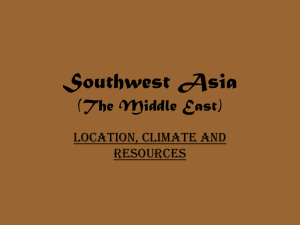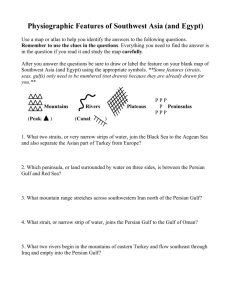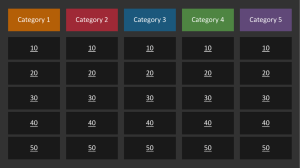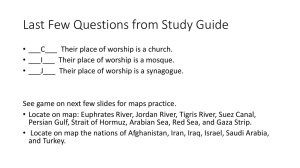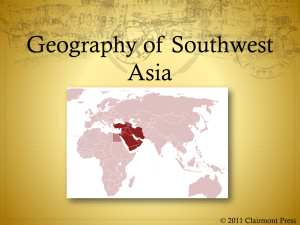6 om as a public service of the RAND Corporation.
advertisement
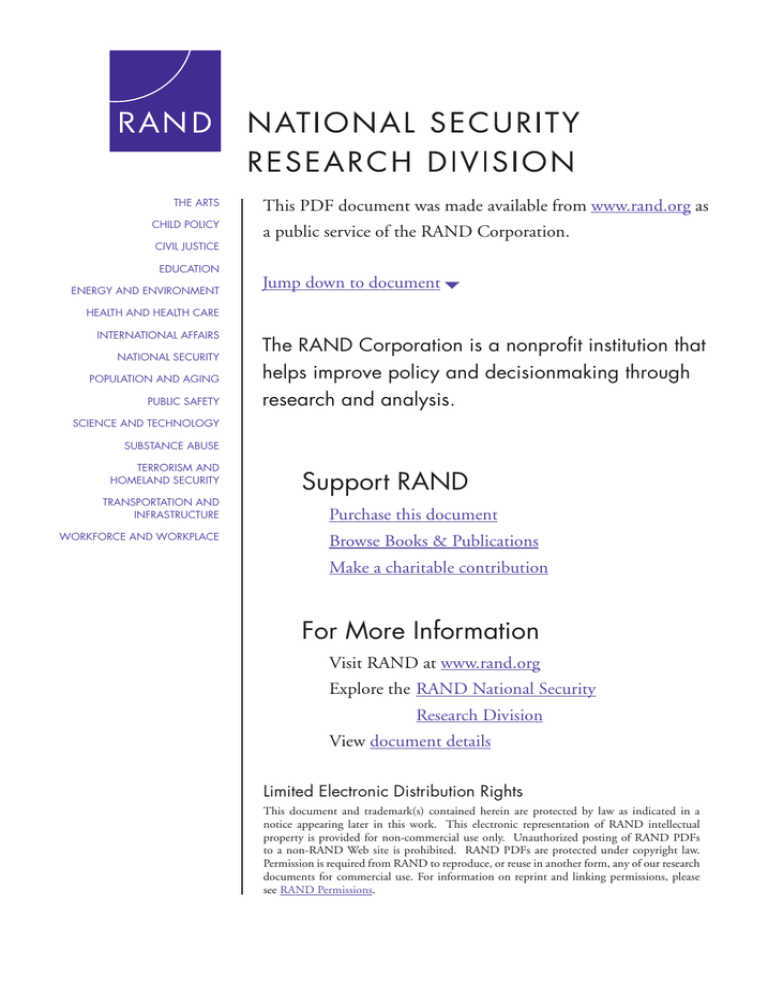
THE ARTS CHILD POLICY CIVIL JUSTICE EDUCATION ENERGY AND ENVIRONMENT This PDF document was made available from www.rand.org as a public service of the RAND Corporation. Jump down to document6 HEALTH AND HEALTH CARE INTERNATIONAL AFFAIRS NATIONAL SECURITY POPULATION AND AGING PUBLIC SAFETY The RAND Corporation is a nonprofit institution that helps improve policy and decisionmaking through research and analysis. SCIENCE AND TECHNOLOGY SUBSTANCE ABUSE TERRORISM AND HOMELAND SECURITY TRANSPORTATION AND INFRASTRUCTURE WORKFORCE AND WORKPLACE Support RAND Purchase this document Browse Books & Publications Make a charitable contribution For More Information Visit RAND at www.rand.org Explore theRAND National Security Research Division View document details Limited Electronic Distribution Rights This document and trademark(s) contained herein are protected by law as indicated in a notice appearing later in this work. This electronic representation of RAND intellectual property is provided for non-commercial use only. Unauthorized posting of RAND PDFs to a non-RAND Web site is prohibited. RAND PDFs are protected under copyright law. Permission is required from RAND to reproduce, or reuse in another form, any of our research documents for commercial use. For information on reprint and linking permissions, please see RAND Permissions. This product is part of the RAND Corporation monograph series. RAND monographs present major research findings that address the challenges facing the public and private sectors. All RAND monographs undergo rigorous peer review to ensure high standards for research quality and objectivity. building security in the persian gulf RobeRt e . HunteR Approved for public release; distribution unlimited NAT IONAL S E C URI TY RE S EA RC H DI VISION This report results from the RAND Corporation’s continuing program of self-initiated research. Support for such research is provided, in part, by the generosity of RAND’s donors and by the fees earned on clientfunded research. Library of Congress Cataloging-in-Publication Data Hunter, Robert Edwards, 1940Building security in the Persian Gulf / Robert E. Hunter. p. cm. Includes bibliographical references. ISBN 978-0-8330-4918-6 (pbk. : alk. paper) 1. Security, International—Persian Gulf Region. 2. Persian Gulf Region—Strategic aspects. I. Title. JZ6009.P35H86 2010 355'.0335536—dc22 2010017767 The RAND Corporation is a nonprofit research organization providing objective analysis and effective solutions that address the challenges facing the public and private sectors around the world. R AND’s publications do not necessarily reflect the opinions of its research clients and sponsors. R® is a registered trademark. Cover photo: NASA, Visible Earth (http://visibleearth.nasa.gov/) © Copyright 2010 RAND Corporation Permission is given to duplicate this document for personal use only, as long as it is unaltered and complete. Copies may not be duplicated for commercial purposes. Unauthorized posting of RAND documents to a non-RAND Web site is prohibited. RAND documents are protected under copyright law. For information on reprint and linking permissions, please visit the R AND permissions page (http://www.rand.org/ publications/permissions.html). Published 2010 by the RAND Corporation 1776 Main Street, P.O. Box 2138, Santa Monica, CA 90407-2138 1200 South Hayes Street, Arlington, VA 22202-5050 4570 Fifth Avenue, Suite 600, Pittsburgh, PA 15213-2665 RAND URL: http://www.rand.org To order RAND documents or to obtain additional information, contact Distribution Services: Telephone: (310) 451-7002; Fax: (310) 451-6915; Email: order@rand.org Summary With the winding down of the U.S. military engagement in Iraq and with other developments in the region of the Persian Gulf, the United States, along with its allies and friends, faces the need to define a long-term strategy for the region. Part of that strategy will relate to immediate issues of continuing U.S. involvement in Iraq, part to challenges posed by Iran, part to developments in nearby Southwest Asia (i.e., Afghanistan and Pakistan), part to the continuing Arab-Israeli conflict, and part to the overall U.S. position in the region and its reputation for “getting right” its strategy and approach to the region and the steps taken to implement them. The nature of U.S. and Western interests in the region—e.g., the secure export of energy, stability and predictability, counterterrorism, relations with other great powers, geopolitics and geoeconomics in general—means that the United States will have no choice but to remain a deeply engaged power in the region. Of course, the terms, conditions, qualities, dimensions, and application of that power and related influence are subject to debate, decision, and responses to events that have not yet happened or, in some cases, even been imagined. But the United States’ continued, indeed permanent, engagement in the region has already been determined by its interests. There are many elements to consider and questions to be answered. This work focuses on two. The first is the best strategy and approach to promote medium- to longterm security and stability in the region as a whole, consonant with the basic interests of the United States, its allies and partners, and the interests of regional countries that are prepared to value the reduction of both tensions and the risk of conflict more than pursuing national ambitions that are divisive and could lead to conflict. The second element considered here is based on two premises: First, for the United States to continue playing a major role in the region’s security, that role must be grounded in strong popular support at home; second, there is, thus, value in finding means to promote regional security and stability at a lower cost than is now being exacted from the United States in terms of blood, treasure, and opportunity costs. If these premises are correct, then canvassing and analyzing such means is worthwhile, indeed, indispensable. This analysis focuses on setting parameters for a regional security structure that is designed to have a high degree of likelihood of covering the key factors in play. Eight xi xii Building Security in the Persian Gulf basic, region-specific sets of parameters need to be considered in formulating a new security structure for the Persian Gulf region: the future of Iraq; Iran; asymmetric threats; regional reassurance; the Arab-Israeli conflict; regional tensions, crises, and conflicts; the roles of other external actors; and arms control and confidence-building measures. The Future of Iraq The U.S. drawdown of forces from Iraq would be facilitated if the foundations were being laid for a new security structure for the Persian Gulf, thus firmly placing U.S. policy toward Iraq in a regionwide and long-term context. Those foundations would then provide the basis for devising a more-elaborated structure able to deal with a broad range of Persian Gulf security requirements. A first-step structure, based on short-term needs in Iraq, should include the following elements: • diplomacy, including a regional conference or conferences that would bring together all the parties relevant to Iraq; a commitment from all parties to the basic goals for Iraq, which are based on its independence, sovereignty, and mastery in its own house, plus an agreement not to use force to affect developments there • participation in multilateral diplomacy by the United States, Iraq, Iran, Turkey, and the Gulf Cooperation Council (GCC) states, along with the United Nations (UN) and other countries and international bodies by common agreement • a joint commitment from all regional parties to oppose terrorism in Iraq in all forms and from all sources • the creation of a Standing Military Commission, composed of all the core members of multilateral diplomacy relevant to Iraq and run under Iraqi leadership, to agree on definitions regarding the long-term military situation in Iraq, to develop limitations on outside involvement, to create a system of inspections, and to devise confidence-building measures (CBMs) • the creation of a Standing Political Commission, with the same membership as the Standing Military Commission and also run under Iraqi leadership, to clarify the interests of all parties, to build political confidence in one another’s activities, to develop tools for dealing with terrorism, and to create expert teams to assess Iraqi material requirements (e.g., reconstruction and development), all as a prelude to future donors’ conferences • development of the concept of the Standing Military Commission and the Standing Political Commission for use in a regionwide security structure. Summary xiii Iran Iran is currently the most-important country in the region in terms of the future of Persian Gulf security and stability. For many years, the United States has operated on the assumption that Iran will be largely uncooperative. Recently, this assumption has been reinforced both by the continuing standoff over Iran’s nuclear program and by a compound of Iranian statements and actions. Yet, this assumption is worth reexamining. On the one hand, Iran is obviously pleased to see the United States reduce its presence in Iraq, not least because of the proximity of U.S. military forces to Iranian territory. It might, thus, calculate that now is an ideal time to try increasing its influence in Iraq, in part to pursue overall regional ambitions. On the other hand, Iran also needs to be wary of an Iraq that is in turmoil, and it might be willing to assist in stabilizing that country. Which perspective will prevail will likely be clarified during 2010, and it is also likely to be affected by what else is happening—or not happening—in U.S.-Iranian relations. There is less uncertainty about the potential for Iranian cooperation, whether tacit or explicit, with the United States and other members of the International Security Assistance Force (ISAF) in Afghanistan. There is some clear correspondence of interests between the two parties, including opposition both to the return to power of the Taliban and to the capacity of Al Qaeda to operate from Afghan (or Pakistani) sanctuaries. How compatible interests might translate into positive cooperation is another matter, however. At the same time, for most Arab states of the Persian Gulf, a key criterion for judging the U.S. drawdown from Iraq and other U.S. policies in the region is whether the United States remains willing and able to thwart Iranian ambitions, not just vis-àvis Iraq but also in the region of the Persian Gulf in general. The apposite point for this work is whether Iran would be prepared to play a constructive part in a regional security structure. It has, for some time, been willing to consider security arrangements with regional countries, and it has even proposed a broad-ranging structure, but with the proviso that the structure be composed solely of regional states. In the end, the issue is whether Iran would indeed be prepared to take part in a regional security structure that did involve outsiders, especially the United States and its allies and partners. And, if such a structure were created—that is, if it were not based on the existence of a hostile “other” but rather on promoting security for all—would Iran see its interests as being better served by being inside or outside? To be eligible to take part in a security structure, Iran would also have to meet some U.S. criteria, including the resolution of the nuclear issue; Iranian abstention from troublemaking in Iraq; Iranian cooperation in Afghanistan (reciprocated by the United States and the North Atlantic Treaty Organization [NATO]); and Iranian abandonment of both support for terrorism and opposition to Arab-Israeli peacemaking. By the same token, Iran would no doubt have its own list of requirements, which could xiv Building Security in the Persian Gulf include security guarantees in exchange for meeting the West’s requirements, the lifting of all economic sanctions, an end to efforts to destabilize the regime or dismember Iran, some role in both Iraq and Afghanistan, and recognition of a significant role for Iran in the Persian Gulf. These two lists need not be incompatible. They should be the basis for negotiation, and those negotiations, to have a chance of being effective, need to be comprehensive and inclusive of all issues. Even if negotiations succeeded—a difficult achievement— there would still be value in a regional security structure that would serve as both a firebreak against uncertainties and a means of dealing with inevitable tensions and disagreements. There would also be value in starting with limited Western cooperation with Iran to test the possibilities—a holistic approach conducted step by step. Afghanistan is the obvious place to begin such cooperation. Asymmetric Threats Some of the most-significant players in terms of regional security are not states but nonstate actors, especially such terrorist groups as Al Qaeda but also other groups that challenge authority through extralegal means or could use violence to forestall the emergence of a viable security structure. A generic term for conflict involving relatively low-cost tools with a potentially high pay-off is asymmetric warfare, which is a limited form of force equalizer. Asymmetric warfare, as practiced by insurgent or terrorist groups, has three basic objectives. First is the appeal to hearts and minds through either positive or negative tactics. Second is the use of relatively low-cost instruments (e.g., improvised explosive devices) for tactical gains against relatively high-cost instruments or classic military tactics. Third is the effort to cause political change on the part of the government under attack—ideally, its overthrow—or to affect the politics and the policies of external states that are supporting the government. The issue of asymmetric warfare is relevant to a new security structure in the Persian Gulf in at least three ways. First is the question whether all participants will foreswear asymmetric warfare. Iran is the key focus of this question in terms of states, but Al Qaeda in Iraq, the Partiya Karkerên Kurdistan [Kurdistan Workers’ Party] (operating against Turkey), and some individuals and groups in Saudi Arabia are also primary concerns. Second, there needs to be agreement, including a formal antiterrorism compact that applies also to the Levant, to oppose any use of asymmetric warfare. Third, efforts by local states to oppose asymmetric warfare are needed if they expect the sustained involvement of external states, especially the United States and European countries. Local governments cannot turn a blind eye to asymmetric warfare in their midst and expect the United States and others to be engaged in promoting security and stability. Summary xv Regional Reassurance The development of a new security structure for the Persian Gulf cannot just be an excuse for a reduction in U.S. involvement in the region. It must also account for expectations on the part of regional states and others about the future role of the United States in the region, whether it acts on its own or in league with European and other allies and partners. There are five key elements to providing reassurance: • The United States should continue conducting the withdrawal and repositioning of its forces from Iraq within a valid strategic framework that accounts for its own interests and those of key regional and extraregional countries rather than in a way that could be represented as war weariness. Indeed, developments in Iraq could require the United States to slow, stop, or reverse its force drawdown. • The United States can continue to bolster the defenses of regional Arab states in the face of concerns about Iran’s development of ballistic missiles, its nuclear program, and its intentions in the region. But care needs to be taken to calibrate the implementation of this policy so that it does not itself further stimulate a potentially uncontrollable regional arms race and preclude possible Iranian participation in a regional security structure at some point. • The United States could reposition its military forces to provide reassurance to regional countries, but, in so doing, it should avoid areas where the sheer presence of U.S. forces could have a lightning-rod effect of negative popular reaction. It should also avoid adopting force types, quantities, and configurations that could prove destabilizing. There would be great value in communicating to all parties what the United States is doing and in consulting with others to avoid misunderstandings. Further, any challenges to regional states from Iran are less likely to be made in military than in nonmilitary terms. Thus, local countries need to rely more on their own devices, including control of migration and investment flows, unless matters get so out of hand that the United States is pressed to become involved. Regional states will also need to judge whether “security” can be promoted by the willingness and ability of the United States and other Western countries to forge workable relationships with Tehran, an avenue that some regional countries are themselves already exploring. • The United States could consider providing formal security guarantees to regional states against aggression from their neighbors and, potentially, against threats from sources external to the region. It will also need to continue playing a major role in countering terrorism in the region. • Through diplomacy, the United States needs to foster among others a positive appreciation of what it is doing and is prepared to do in the future; in some cases, it may need to take steps to produce a deterrent effect in regard to potentially hostile countries. Such efforts could include promoting development of a regional xvi Building Security in the Persian Gulf security structure, provided that it is not characterized as an effort by the United States to gain political dominance in the region or, by contrast, to wash its hands of the region’s problems. The Arab-Israeli Conflict Calculations about Middle Eastern politics and U.S. engagement in the region continually return to the Arab-Israeli conflict and, more particularly, to Israeli-Palestinian relations. Conventional wisdom holds that continued lack of resolution of the IsraeliPalestinian conflict inhibits the United States’ pursuit of its interests elsewhere in the region, including the creation of viable security arrangements. Conventional wisdom also holds that the United States’ European allies expect Washington to take an active role in pushing this conflict toward conclusion—if not pressing it to a full conclusion—in return for their cooperation elsewhere in the region. But how accurate is the conventional wisdom? If asked, virtually everyone in the Arab/Muslim states in the region and in Europe asserts that the United States must play an active, committed role and drive the process to closure. But this is not the same as a requirement. Nevertheless, U.S. efforts in the Middle East, overall, are clearly affected negatively by popular attitudes in the Muslim states of the region regarding the U.S. role in the Palestinian issue. Thus, for all these reasons, U.S. efforts in the Middle East as a whole would certainly not be made more difficult if the IsraeliPalestinian conflict were settled. The United States is also likely to gain standing in the region and with allies if it is actively and seriously engaged in seeking that end, as President Barack Obama is now doing. Further, issues relating to Israel’s security and to Iran’s role in the Middle East (especially its nuclear program) would, unless dealt with effectively, vastly complicate any U.S. efforts to foster a new security system for the Persian Gulf. In at least this element, therefore, there is a clear linkage between the zone of Arab-Israeli conflict and the Persian Gulf and Southwest Asia. In Israeli-Palestinian peacemaking, however, the devil rests less in the details than in the nature, character, and development of underlying politics and societies. Many Israelis are still not willing to take the classic risks associated with achieving peace. It is also far from clear that there is a valid partner for peace for Israel; indeed, finding one is unlikely to be possible until Gaza ceases to be largely ignored and is instead provided the massive external economic and humanitarian support needed to begin weakening the hold of Hamas. Furthermore, in its current isolation, Gaza is fertile ground for Islamist terrorism’s recruiters. At the same time, leading Arab states are waiting to see whether Israel will be prepared to take both substantive and symbolic steps—notably, on its settlements policy—and whether the U.S. president is prepared to run his own risks for peace, denominated, in part, in terms of U.S. politics. For his part, President Obama cannot succeed in pressing serious peace efforts beyond a limited point with- Summary xvii out prior progress within Israeli and Palestinian politics and society, including an end to Gaza’s isolation. Nor will he be able to count on support from Arab states until he shows his own commitment to move forward, not just on tactical issues, such as Israeli settlements, but on the big issues that must eventually be resolved. The interplay of all these factors argues that the default option should be active U.S. diplomatic engagement in trying to resolve the Israeli-Palestinian conflict and concurrent efforts to reduce threats—to countries in the Persian Gulf region and to others, such as Israel—and to build the basis for lasting security in the Persian Gulf. Regional Tensions, Crises, and Conflicts Any viable security structure also has to take account of tensions, crises, and the possibility of conflict, including destabilization, between its members. Both Turkey and Iran have concerns on the last-named score. Meanwhile, there have been serious tensions in Qatari-Saudi relations; indeed, such tensions may help to explain why Qatar welcomes the U.S. military presence in that country. Also, relations between Saudi Arabia and Bahrain have not always been cordial, and neither have those between Saudi Arabia and Yemen. There are also occasional stresses in relations between Saudi Arabia and the United Arab Emirates. The Iraqi government keeps a wary lookout for potential interference from various directions, including some of its Arab neighbors. Relations among GCC members could also deteriorate for one or another reason. Some Persian Gulf governments considering whether to join a formal security structure could also seek support against internal political change. But it is one thing to require that neighbors pledge not to engage in or tolerate subversion and another to require that each member of a regional security structure assist another whose government is being challenged from within. Trying to write that provision into a treaty could put more weight on the arrangements than they can bear. The Roles of Other External Actors Since the onset of serious difficulties following the 2003 invasion of Iraq, the United States has already moved significantly in the direction of seeking support from allies and partners in the Middle East. The Europeans After the 2003 invasion, the United States had no choice but to take the lead in devising some alternative to the old structure of regional security. Since then, however, it has moved toward seeking support from allies and partners in the Middle East. Most of these allies and partners now accept that they cannot stand aloof from what happens xviii Building Security in the Persian Gulf in the region. Not all see eye to eye with the United States on the nature of the challenges or on the potential remedies, but there is broad agreement that the United States cannot be expected to bear a vastly disproportionate share of the responsibility to act. This is part of an emerging bargain: The United States will continue to be deeply engaged in European security, but it needs support from its allies in the Middle East and Southwest Asia, as far east as Afghanistan and even Pakistan. Furthermore, in many parts of the Persian Gulf region, some Western countries can be more effective than the United States because they do not carry the political baggage of being the legatee of others’ colonialism, the invader of a regional country, or a strong supporter of Israel. European states are also well placed to train local security personnel and to provide nonmilitary support. The United States should continue to encourage the involvement of European governments, even at the price of ceding some primacy, sharing political influence, and accepting joint decisionmaking. Other Key External Powers The potential or actual engagement of other external powers in the Persian Gulf cannot be ignored, especially because of the region’s hydrocarbons. But do any of these actors need to be involved in a new security structure for the region? India and China are developing both interests and ambitions, but it is not clear how much either could contribute or, by contrast, whether they would have the incentives or the ability to confound others’ arrangements. They stand to gain assurances about hydrocarbon flow as a free good. Decisions about their potential roles can, thus, probably be made somewhat later. Russia is a different case. It already plays roles in the Middle East, notably in the so-called Quartet for Arab-Israeli peacemaking. It has involved itself in the issue of U.S. supply routes to Afghanistan, and it has a strong interest in the transportation of hydrocarbons from Central Asia and the Transcaucasus. It is seeking, in general, to return to the ranks of great powers, which implies increased engagement in issues of the Middle East and Southwest Asia. Perhaps most consequentially, Russia has been part of ongoing negotiations regarding the future of Iran’s nuclear programs. No doubt, however, it has its own interests regarding Iran and the region as a whole. Thus, should Russia be invited to join a new security structure for the Persian Gulf? A Russia that is passive but supportive, as it has tended to be in the Quartet, should be welcomed. But Russia’s own attitude will depend in part on Iran’s stance toward a regional security structure. If Tehran were obdurate, this could work to Moscow’s advantage. But if Tehran were positive, then Moscow’s role would be diminished. The bottom line is that the creation of a regional security structure should include exploring possibilities with Russia and trying to create incentives for it to be cooperative. Summary xix Building Blocks for a Regional Security Structure In a security structure for the Persian Gulf, there can be value in creating formal political and security commitments among its members. One common form is collective security, which is an “all-the-rest-against-one” approach in which all members agree to support one another against a possible threat from one or more of the members (an example of such an organization was the League of Nations). Another popular form of security commitment is collective defense (an example is NATO), a form in which all the parties agree to come to the aid of any alliance member threatened from outside: an “all-for-one-and-one-for-all” approach. This work makes no a priori judgment about the need for treaty commitments. Instead, it takes a building-block approach, analyzing possible alternative approaches to security—while setting parameters—that could be drawn upon for a viable security structure. Holding off on making politically binding mutual security commitments until functional arrangements are developed can have two benefits: It can preserve flexibility regarding future membership (e.g., for an Iran that is not part of initial efforts) and it can avoid problems that could arise if regional states are wary, at least at first, of making formal commitments to one another. Potential Models or Partners In assessing possible building blocks for a regional security structure for the Persian Gulf, it is worth canvassing alternatives based on experience elsewhere. These potential partners or models are discussed in this section. Determining what can be done to build a security structure for the Persian Gulf will have to take account of the region’s unique features. Like all other security structures in different parts of the world, this one will have to be sui generis. Nevertheless, experience elsewhere can be instructive and offer precedent or practice to inform efforts within the region. One distinction can be made between models of other cooperative efforts or institutions that are based solely on regional states and those that involve outsiders. There are advantages to the former, especially in cases where, as in a number of countries in the Persian Gulf region, the involvement of outside military forces could have a negative effect. By contrast, there can be circumstances in which the involvement of outsiders can have a reassuring quality by demonstrating to local states that their security matters to, say, the United States, and that they would be backed up when need be. The following are summaries of possible models or partners for regional states in developing a regional security structure: • NATO involvement. NATO is already involved in the Persian Gulf region via both the NATO Training Mission–Iraq, which will continue for the foreseeable future, and its leadership of ISAF. For some aspects of a Persian Gulf regional security structure, that experience could be apt. NATO’s Istanbul Cooperation xx Building Security in the Persian Gulf • • • • • Initiative (ICI) includes four of the six members of the GCC—Saudi Arabia and Oman do not participate—and offers NATO support in functional areas, notably training. Allied Command Transformation also offers significant possibilities for cooperation, as do NATO facilities made available to non-NATO militaries for training and similar purposes. The NATO model. The roles of two NATO institutions might be instructive in the Persian Gulf region. Partnership for Peace (PFP) has proved to be highly effective in enabling states that emerged from the wreckage of the Soviet Union, the Warsaw Pact, and Yugoslavia to develop the tools of military modernization and cooperation. A key function of PFP has been to help damp down tensions and differences between different members. The Euro-Atlantic Partnership Council now provides a forum in which any of these countries can raise their security concerns, especially concerns about each other. Another NATO effort, the coordination of measures for disaster relief through the Senior Civil Emergency Planning Committee, could also provide a model for cooperation among Persian Gulf states. European Union (EU) involvement. In certain circumstances, the EU could make available its crisis-management capabilities (through its Common Foreign and Security Policy [CFSP]) and even limited military engagement (through its European—now Common—Security and Defence Policy [ESDP/CSDP]), although these capacities are very limited. One virtue of EU involvement would be that it is “not NATO” and “not the United States”—facts that might prove more politically appealing to some Persian Gulf states. The EU model. Despite the formal creation of a Gulf Common Market in 2008, anything like the EU in the Persian Gulf is decades away from being established. However, there are lessons to be learned from European experience in terms of conflict- and tension-reduction through economic cooperation. The CFSP and CSDP experiences meld different approaches to or phases of security into a “onestop-shopping” model. A Conference on Security and Co-operation for the Persian Gulf (CSCPG). This organization could be patterned on the Conference on Security and Co-operation in Europe (CSCE), which was designed to help reduce tensions during the Cold War, when different countries wanted to explore ways of cooperating even during a time of basic geopolitical and ideological conflict. Indeed, CSCE proved to be a critical part of the process of bringing the Cold War to an end. At the very least, the “Basket One” aspects of CSCE—basically, security cooperation—might be usefully adapted to a CSCPG in making possible a range of relations between Iran and the Arab states of the Persian Gulf without any of the local countries having first to cede basic approaches or to compromise their interests. An Association of Persian Gulf Nations. This organization would be patterned on the Association of Southeast Asian Nations (ASEAN), with its ten member states, Summary xxi and on ASEAN’s Treaty of Amity and Cooperation in Southeast Asia, which incorporates 17 non-ASEAN members, including the United States, Russia, China, and the EU. The virtues of this model are that it has developed slowly; it includes tension-reduction mechanisms; it does not require that all disputes be resolved before countries can join; and it relates politics, economics, and security together. The treaty also provides a role for external countries if and when regional countries see this role as beneficial. • The Organization of the Islamic Conference (OIC). All potential regional members of a Persian Gulf security structure belong to the OIC, which includes a rudimentary mechanism for the peaceful settlement of disputes and a convention for combating international terrorism. There are elements of OIC policy and practice that could be useful in developing a security structure for the Persian Gulf. Arms Control and Confidence-Building Measures The development of a new security structure for the Persian Gulf region should include both arms control and CBMs. These can help introduce more rationality into the process of determining security requirements and could lead different parties to adjust their policies. Indeed, the impact that regulating military relationships can have on political relationships should not be underestimated. Step one is to keep the military dimension from dominating the politics. An example of a way to do this is to recognize the need to prevent the emergence of a balance of forces that is inherently instable. This is particularly true where weapons of mass destruction are involved. The following are arms-control measures and CBMs that could be useful parts of a Persian Gulf security structure: • multilateral political and military commissions, whether they include outside powers, such as the United States and European states, or are limited to regional powers. These commissions, patterned on the U.S.-Soviet Standing Consultative Commission created by the 1972 Anti-Ballistic Missile Treaty, would develop techniques for fostering stability. • an incidents-at-sea agreement patterned on that between the United States and the Soviet Union in 1972 • a freedom-of-shipping agreement designed especially to create additional confidence in shipping through the Strait of Hormuz, which is important to all littoral states • counterpiracy cooperation, which would be in the common interest of all Persian Gulf maritime nations in countering the rising phenomenon of piracy in the Red Sea and environs • a counterterrorism compact, including practical efforts and cooperation to defeat terrorism xxii Building Security in the Persian Gulf • a weapon catalog as a prelude to arms control, which would provide a basis for calculating military balances of power, an important element of a security structure • limitations on sales and supplies of weapons that could be destabilizing. These limitations would be accepted by regional states and established in cooperation with supplier states. Summary of Recommendations Important criteria for an effective regional security structure include the following: • a critical mass of regional states that see taking part in the structure as more likely to provide security than abstaining from or working against it • willingness to pursue arms-control measures and CBMs, including – establishing multilateral political and military commissions to reduce tensions and the risk of conflict – creating CSCE-like arrangements (i.e., a CSCPG) – developing PFP-like relations among states – establishing an incidents-at-sea agreement, a freedom-of-shipping agreement, counterpiracy cooperation, and a counterterrorism compact; cataloging (and defining) military capabilities; and limiting the acquisition of weapons in the region – adopting nonmilitary (especially economic) cooperation and integrating military and nonmilitary approaches to security – creating means to limit or resolve intraregional squabbles, tensions, and crises • the integration of regional security efforts within a formal UN mandate to create a rule-of-law basis for cooperation • the creation of a security structure premised either on universal membership or, if a “hostile” state is in the mix, on pursuing containment (but with the possibility of universal membership in the future) • roles for outside institutions, notably NATO (e.g., through the ICI) and the EU (e.g., through an enlarged EU Mediterranean Initiative) • a method of dealing with asymmetric threats posed either by member states on their own or with external partners (e.g., such countries as the United States or such institutions as NATO and the EU) • roles (if any) for Russia, China, and India • possible security pledges by outsiders, perhaps including deployed forces or other demonstrations of presence and commitment • outsider involvement in training and other security-support roles • progressive, rather than one-time, development of the security structure, including a series of regional security conferences • long-term efforts aimed at internal social, economic, and political development.
